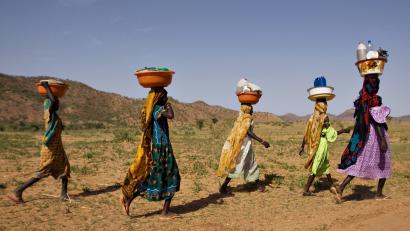Climate Change is Worsening Armed Conflict in Sub-Saharan Africa
Patrick Condon
Staff Writer
Climate change has become one of the gravest threats to world peace and induces fragility in nearly every corner of the world. However, while global temperatures are changing, armed conflicts simultaneously pose a more immediate, tangible threat. These two issues are frequently portrayed in dialogue as unrelated, yet there is a close relationship between climate change and armed conflicts, especially in sub-Saharan Africa where insecurity threatens millions of lives. Through rapid desertification and environmental degradation, sub-Saharan Africa now finds itself stuck in the crossroads of climate change and regional insecurity.
Climate change is a threat multiplier which, according to the Hague Institute for Global Justice, is characterized by its ability to “[exacerbate] existing socioeconomic stress factors in societies with high exposure, high levels of poverty, and little institutional capacity to mitigate or adapt to climate change.” As such, conflict is rife in the continent’s Sahel region, one of the driest and hottest places in the world that cuts through states with some of the world’s lowest levels of human development like Sudan and Nigeria, according to the United Nations Development Programme. The lack of reliable clean food and water, coupled with governmental institutional instability, has compromised the population’s ability to achieve peace and security. Armed conflicts in sub-Saharan Africa have resulted in approximately 142,000 deaths and millions of people displaced in the past 8 years, as noted by the Stockholm International Peace Research Institute.
Sudan is located in sub-Saharan Africa and is made up largely of desert in the north with grassland plateaus and grazing land near the Sahel in the south. It receives an average of 25 centimeters of rainfall per year, falling almost entirely in the southern half, according to World Bank data. As reported by the FAO, Sudan’s agricultural industry historically comprised 33% of GDP until climate change sparked droughts within the past two decades. As climate change began pushing the Sahel region of the Sahara closer towards the southern plateaus in the 1980s, Action on Armed Violence says, “prolonged periods of drought, intense desertification, and soil erosion persisted, resulting in depleted productivity of land and changes in grazing patterns.” This environmental degradation caused immediate insecurity in the short term while creating the environmental and social conditions for one of the worst humanitarian crises of the past century. Sudan’s environmental status and characteristics are not unique, however, as another Sahel nation – Nigeria – shares similar environmental and social struggles exacerbated by climate change.
Nigeria is a West African state with a climate is like that of Sudan, varying from a desert steppe climate in the north to tropical rainforests in the south. While the country tends to be more humid than Sudan, this has not spared its northern provinces from serious desertification, particularly around Lake Chad in the northeast. Since 1960, Lake Chad has lost 90% of its surface water to desertification and overuse, per ANS data. As Lake Chad currently provides water for rapidly growing populations in Nigeria, Niger, Chad, and Cameroon, there is increased water insecurity and reduced crop production due to a 53% reduction in rainy days since the 1970s. These conditions have thrown 7 million people in the region into a state of food insecurity, as identified by UNHCR. The growing threat of desertification spreads insecurity and heightens the risk for conflict in Nigeria’s northeast region.
Both Sudan and Nigeria maintain large agricultural industries, characterized by two distinct farming practices. The main agricultural dichotomy in both countries is characterized by settled farming versus nomadic herding. According to the Belkhir Journal, in Sudan, nomadic Arab pastoralists have been historically restricted from Darfur, the country’s westernmost region, where settled African farmers comprised the majority ruling class that established regional governance and agricultural divisions. By comparison, Nigeria lacks explicit governmental divisions of agricultural practices, allowing geography to naturally separate farmers from herdsmen – settled farmers and nomadic Hausa herdsmen divided themselves across the Lake Chad Basin. However, as climate change diminishes natural resources and pastoral land in both Sudan and Nigeria, nomadic herdsmen have been driven into settled farmland, notes TIME. This ecological migration is a prime example of the threat multiplying effect, as climate change is now cramming previously separated populations into arable, yet finite land.
As Lake Chad dries up, Nigerian Hausa herdsmen have been forced southward, resulting in territorial conflicts between herdsmen and farmers. According to NPR, in 2018 alone, conflicts between herdsmen and farmers in Nigeria caused over 2,000 casualties, a count that tops all terrorism-related deaths from Boko Haram in that same time frame. Nigeria is a clear case of the multiplying effect of environmentally-driven migration; the situation in Darfur, by contrast, has worsened due to both environmental causes and ethnic tensions. Under colonial rule, African Darfurian farmers were seen as inferior and consequently forced to give up farmland to Arab herdsmen. This power dynamic worsened with the presidency of Omar Al-Bashir, who equipped Arab Hausa nomads with military-grade weapons, leading to widespread violence and further division of horticulturalists, this time along ethnic lines. As conflicts between herdsmen and farmers become more intense – and climate change more severe – regional insecurity is skyrocketing and forcing civilians to flee from their homes.
The conflict in Darfur reached new heights with the establishment of various militias equipped with government-issued weapons to force farmers off their land. This government-supported policy of aggression spawned two rebel movements: the Sudan Liberation Army (SLA) and the Justice and Equality Movement (JEM), per Refworld. However, the state’s response to the conflict manifested itself in the formation of the Janjaweed, a horseback militia group accountable for the destruction of over 400 civilian homes, notes Holocaust Memorial Day Trust (HMDT). Since 2003, the conflict between these factions has resulted in approximately 200,000 casualties and 3.57 million displaced, 350,000 of whom have fled to neighboring countries, according to UNHCR. While the government has made efforts to provide security to people in Darfur, it has been largely discriminatory towards settled farmers, who are left at the hands of the Janjaweed militia. The situation in Darfur persists, endangering millions in and around the region and threatening the long-term sustainability of rapidly shrinking farmland.
Although more recent, the origins of the conflict in Nigeria resemble the early causes of the conflict in Darfur. Just as the situation in Darfur was not directly caused by climate change, Boko Haram’s activities were also started for ulterior reasons, as noted in Climate Diplomacy Magazine. Boko Haram has been primarily focused on weakening Nigeria’s governmental forces to establish a stronghold for radical Islamists in West Africa. The terrorist organization has capitalized on climate-induced water and food insecurity, growing in size and legitimacy via agricultural monopolization. Many former residents of the Lake Chad Basin cannot find reliable food sources outside of Boko Haram-held territory. What was once a historically peaceful division of herders and settled farmers has been erased by intense climate change and opportunistic terrorist organizations, creating the ideal societal instability for recruitment by extremist groups like Boko Haram, as stated by IPS News.
Boko Haram’s dominance in the region poses more than just an immediate threat to security; it has continually prevented the dispersion of governmental and international humanitarian aid. Boko Haram militants are actively seizing land in the Lake Chad Basin, making it unsafe as a source of fish and water. The shrinking of Lake Chad, paired with the militant presence of Boko Haram, has led farmers away from the area and into communities around the Lake Chad Basin that had once been defined by settled farming practices. This situation in northeast Nigeria has also been exacerbated by the subsequent lack of international humanitarian aid to the region. 11 million people in northeast Nigeria currently need humanitarian assistance – aid that is unlikely to arrive soon. UN humanitarian projects are consistently inhibited by the terrorist organization, as “attacks against aid workers in northeast Nigeria greatly impact the ability of organizations to provide life-saving relief to those in desperate need,” states the Soufan Center. Along with the government’s failure to provide security in the region, increasingly common violence has permanently altered the region’s sustainability and environment.
Similar to Nigeria, Darfur has seen tensions peak with the absence of locally accepted government assistance, according to Al Jazeera. The UN peacekeeping forces were initially deployed in 2003 as part of the United Nations African Union Mission (UNAMID) to reduce ethnic violence between the nomads and farmers and open corridors for humanitarian assistance. However, since the mission ended on 31 December 2020, the resulting power vacuum in the region elevated faction leaders among pastoralist and settled farming communities. The UN force’s exit came at a critical time, as the conflict currently “puts vulnerable populations at increased risk and requires far more robust action than we have seen so far,” writes the Hague Institute. Without the necessary security and humanitarian assistance organized by the Sudanese government, millions will continue to be left without aid in a region falling to rapid desertification. What had once started as an environmental issue in the Sahel has now graduated to genocide and further division between Darfurians.
Both conflicts feature similar contexts of social and agricultural differences between groups. The HMDT notes that much of the discussion of conflict in Darfur is centered around ethnicity, as experts mainly point to former President Omar Al-Bashir’s campaign to equip settled farmers with weapons that contributed to what has officially been called a genocide. However, the conflict in Darfur, just as in Nigeria, traces back to environmental degradation from climate change, peaking with a drought that killed 100,000 people between 1983 and 1984, says the Belkhir Journal. This degradation then multiplied with a massive ecological migration towards southern Darfur, leaving large parts of Darfur deserted and without humanitarian security. While the region allowed for a brief period of aid from humanitarian agencies, many international organizations have been expelled and numerous domestic agencies suspended. According to The New Humanitarian, this restriction of aid to endangered civilians has caused more than 305,000 refugees to flee into Chad alone. The case of Sudan serves as a warning to Nigerian efforts against Boko Haram, as it reveals the ineffectiveness of government-organized assistance in Sub-Saharan Africa.
Overall, climate change can multiply threats by weakening domestic agencies’ ability to provide sustainable relief and security. Primarily, “in a changing climate, the context within which these groups operate changes significantly, creating a context within which [armed] groups can proliferate, grow and rise,” states Climate Diplomacy Magazine. Both Sudan and Nigeria serve as examples to depict the full effect climate change has on weakening institutions and the growth of armed groups. There is a clear relationship between insecurity and conflict in Sudan and Nigeria, as militancy is easily spread across communities seeking water, food, and institutional security. As humanitarian aid and national actors are unable to reach impacted areas due to severe insecurity, militant groups prey on the isolated, fragile populations through short-term insecurity conflicts. The multiplying effect of climate change has marked Darfur and northeast Nigeria among the most insecure regions in the world, permanently altering the environment while expanding armed conflicts.



